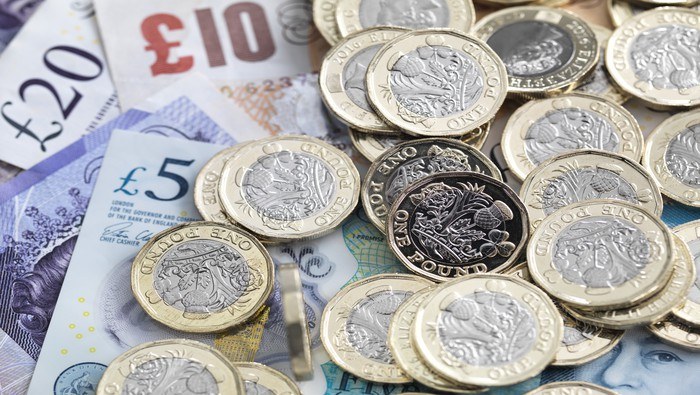Australian Dollar, AUD/USD, AUD/JPY, Easing Border Restrictions, RBA – Talking Points:
- The Australian Dollar may extend recent gains on the back of easing border restrictions.
- Positive economic data may sway the RBA to retain its wait-and-see approach in the near term.
- AUD/USD eyeing the yearly high after breaching key resistance.
- Bearish RSI divergence hints that the AUD/JPY’s impulsive surge may be running out of steam.
Easing Border Restrictions to Underpin AUD
The Australian Dollar has stormed higher in the month of November, climbing over 5% against the US Dollar to come within a stone’s throw of the yearly high set in September.
Prices look set to surpass this peak in the near term, as the nation’s successful suppression of the novel coronavirus allows states to roll back border restrictions.
The border between Australia’s two most populous states – Victoria and New South Wales – was reopened on November 23 after being closed for over 4 months, while Queensland Premier Annastacia Palaszczuk announced yesterday that “on December 1, Victorians can also come to Queensland and Queenslanders can go to Victoria as well”.
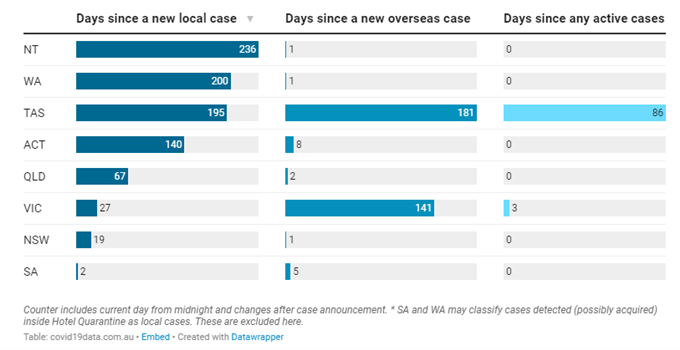
Source – Covid19Data
These moves will likely bolster the heavy-hit tourism, travel and services sectors ahead of the holiday season. Indeed, Flight Centre has registered a record increase in domestic travel bookings while Qantas – Australia’s national carrier – has added hundreds of extra flights to cope with the surge in demand.
To contrast, Germany has extended its nationwide partial lockdown for at least three weeks while Covid-19 hospitalizations in the US skyrocket to just under 90,000, surpassing the peaks seen in April and July by over 25,000.
This stark divergence in health outcomes may put a premium on the Australian Dollar, if the nation can successfully open borders without triggering a fresh outbreak in coronavirus cases.

Source – Google Trends
RBA to Hold Fire on Economic Data
These positive developments, combined with a slew of positive economic data, may also diminish the probability that the Reserve Bank of Australia will ease monetary policy settings further.
The RBA delivered what appears to be its last interest rate cut – for the foreseeable future at least – in November, after stating that “the Board is not contemplating a further reduction in interest rates [and] continues to view a negative policy rate as extraordinarily unlikely”.
The central bank also noted that “recent economic data have been a bit better than expected and the near-term outlook is better than it was three months ago”.
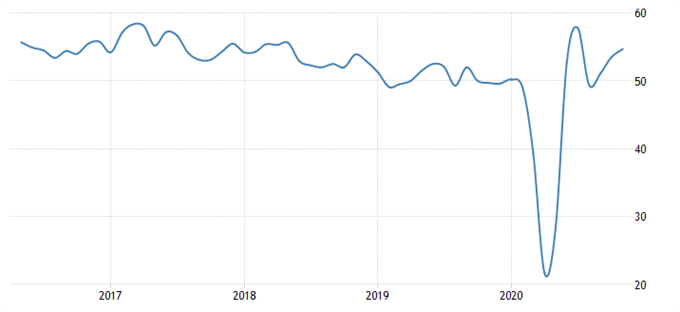
Source – TradingEconomics
The IHS Markit Composite PMI recorded its third consecutive month of expansion as activity in both the manufacturing and services sectors gathered pace, while the seasonally adjusted unemployment rate nudged up to 7% in October – below consensus estimates of a 7.2% print.
Therefore, Australia’s progressive return to normalcy may fuel a swifter rebound in economic activity and sway the RBA to keep its monetary policy setting steady, opening the door for the local currency to continue moving higher against its haven-associated counterparts.



AUD/USD Daily Chart – Yearly High Within Reach
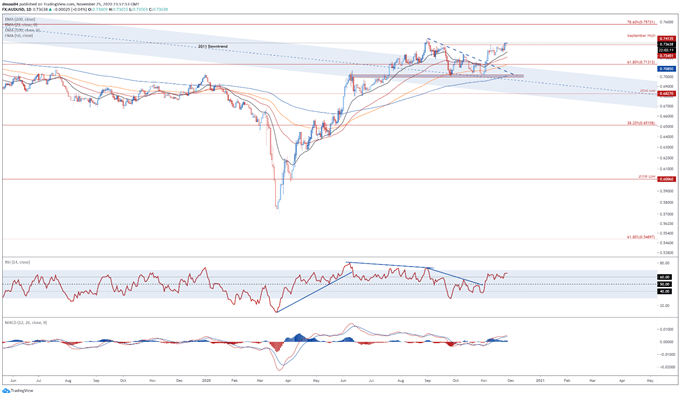
AUD/USD daily chart created using Tradingview
From a technical perspective, AUD/USD rates look poised to challenge the yearly high, after slicing through key psychological resistance at 0.7300.
With the RSI eyeing a push into overbought territory and the MACD indicator storming to its highest levels since early September, the path of least resistance seems to favour the upside.
Ultimately, a daily close above the September high (0.7413) is needed to signal a resumption of the uptrend extending from the March nadir and open the door for prices to challenge the 78.6% Fibonacci (0.7573).
Conversely, slipping back below September 16 high (0.7345) could neutralize near-term buying pressure and generate a pullback towards confluent support at the 100-day moving average and 61.8% Fibonacci (0.7131).

Retail trader data shows 33.61% of traders are net-long with the ratio of traders short to long at 1.98 to 1. The number of traders net-long is 8.61% higher than yesterday and 12.03% higher from last week, while the number of traders net-short is 5.10% higher than yesterday and 4.57% lower from last week.
We typically take a contrarian view to crowd sentiment, and the fact traders are net-short suggests AUD/USD prices may continue to rise.
Yet traders are less net-short than yesterday and compared with last week. Recent changes in sentiment warn that the current AUD/USD price trend may soon reverse lower despite the fact traders remain net-short.
AUD/JPY Daily Chart – Bearish RSI Divergence Hints at Reversal
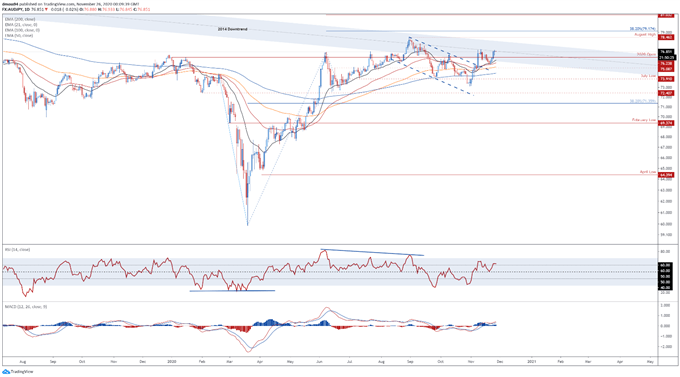
AUD/JPY daily chart created using Tradingview
AUD/JPY rates could be at risk of reversing lower, as prices fails to breach the psychologically imposing 77.00 mark.
Bearish RSI divergence hints that the impulsive surge away from the trend-defining 50-DMA (75.63) could be running out steam.
Failure to hurdle the 2014 downtrend midpoint and the November 11 high (77.10) would probably ignite a pullback towards the yearly open. Breaching that likely bringing key support at 75.00 into play.
Nevertheless, with AUD/JPY tracking firmly above all four moving averages, any pullback may prove short-lived.
With that in mind, a daily close above 77.00 is needed to validate bullish potential and propel prices to challenge the yearly high set in August (78.46).

Retail trader data shows 37.90% of traders are net-long with the ratio of traders short to long at 1.64 to 1. The number of traders net-long is 0.49% lower than yesterday and 1.94% lower from last week, while the number of traders net-short is 6.09% higher than yesterday and 18.21% higher from last week.
We typically take a contrarian view to crowd sentiment, and the fact traders are net-short suggests AUD/JPY prices may continue to rise.
Traders are further net-short than yesterday and last week, and the combination of current sentiment and recent changes gives us a stronger AUD/JPY-bullish contrarian trading bias.
-- Written by Daniel Moss, Analyst for DailyFX
Follow me on Twitter @DanielGMoss









